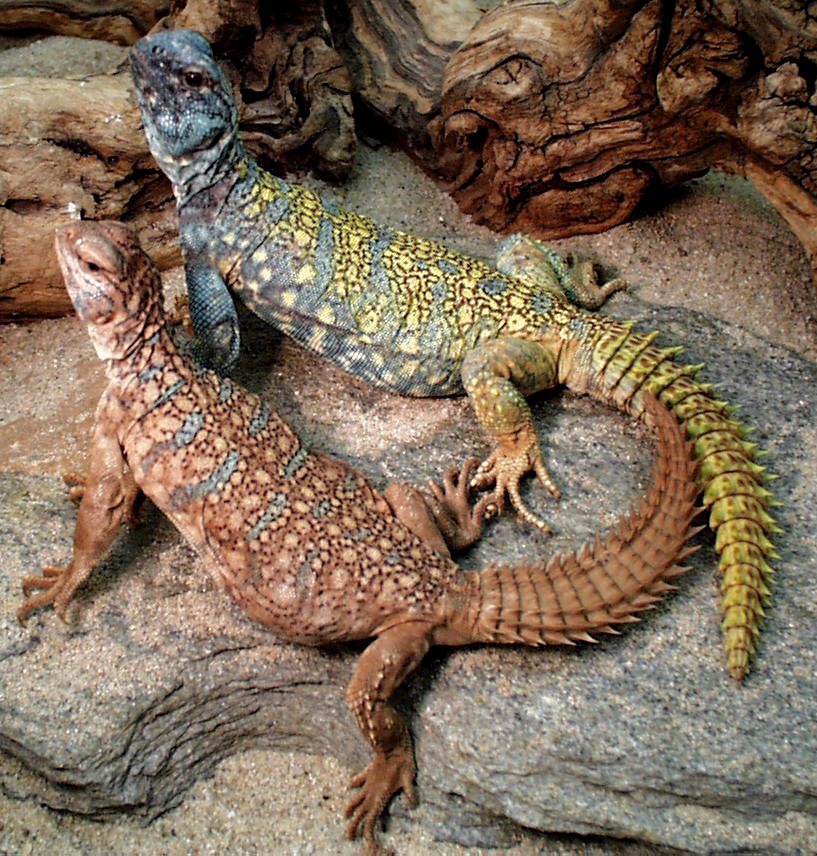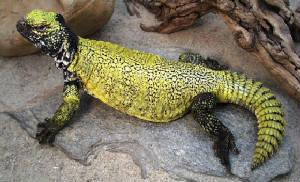|
| U benti / yemenensis |

|
| Navajo |
UROMASTYX
SPINY TAIL AGAMA
There are a number of species and sub species in the
Genus Uromastyx. I will share a few of these majestic creatures, which I’ve worked with since 1995. They are one of
the list’s top candidates when it comes to being great reptile pets. The majority of them share this well earned reputation.
Many occur in hot/dry regions like the Sinai and the Saharan desert. Also throughout the middle eastern and African countries
such as Sudan, Oman, Yemen, Morocco, Egypt, Arabia, Iraq, and Pakistan to name a few.
As wc most will adapt to captivity if the new keepers
follow the basic acclimation process. Some can quickly stress out during this time of transition and may fail. There are many care sheets and helpful forums, which will aid you in getting through this time quickly
and safely. Having a captive bred Uromastyx will most always assure a healthier
lizard which will be calmer and usually more gentle and problem free in general when compared to many or the fresh wild caught
imports.
They are mostly ground dwellers but would quickly climb
an acacia tree for a tasty blossom. They will dig borrows to hide in or when they seek the underground humidity to lay their
eggs in. They may even squeeze into the crevices in rocky outcrops for protection from predators.
| U o macfadyeni |

|
| Young Adult Pair |
An Ideal size
enclosure or tank’s floor space for an adult or even a pair of adult size (10”-14” long) uromastyx would
be 4’W by 2’D and from 18” to 24” in height. Although hatchling to juvenile ages should be kept on
paper till at least six months old, the older ones do well on washed play sand, a rock or two to sit on or climb over and
a sturdy low branch or grapevine as well as a hide or two for them to sleep in/under. Also a good-sized piece of slate or
flat rock for the basking site. Cage lighting and temperatures are most important. A good size cage or tank would be easier
in keeping a good temperature gradient. By this I mean that it is important for them to control their preferred body temperature
by merely moving from one side of the cage to the other. The cool end should be approximately 85F and the warmer side closer
to 100F with the basking site surface in the 120 to 130F range. A spot or flood
light with a dome reflector will help keep their basking site surface nice and warm during the day. A UVB fluorescent light
will discharge ultra violet rays which the lizard will need along with the heat from the basking light in order to absorb
the UVB rays through their skin. This will also keep the lizard more active, keep its appetite at a peak and assist in fecal
elimination on a daily/regular basis. Keeping fresh UVB lights in their enclosures is important because the UVB rays they
absorb during their day will also help keep their bones strong and healthy.
| U a nigriventris |

|
| Lime/Yellow Moroccan Male |
The Uromastyx are mainly herbivores and enjoy some
leafy greens such as collard, turnip and mustard but you can also include some thawed frozen veggies, some yellow squashy
or even some freshly picked rose, hibiscus and dandelion flowers. Just be sure they’re pesticide free. A good rule of
thumb is to rinse them off under the tap before feeding. A good calcium/vitamin supplement should be lightly sprinkled on
their salads once or twice a week. They don’t need a water bowl in their cage as they get all the needed hydration from
their salad. Besides, most uromastyx occur in hot dry deserts and seldom encounter much water at all during their lives.
|

